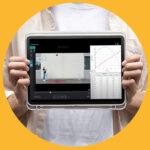
Sharing ideas and inspiration for engagement, inclusion, and excellence in STEM

Note: A version of this story was originally posted on the Vernier website in August 2020.
When Gilbert Classical Academy in Gilbert, Arizona, switched to remote learning because of COVID-19, science teacher Erik Gillman wanted to find a way for his AP Physics students to continue engaging in data analysis.
His solution: “The Line Rider Rides Again!” investigation, which he created by incorporating a popular simulated physics game with the Vernier Video Analysis® app.
Engaging Students
As detailed in the investigation, Line Rider is an online game created in 2006 by a Slovenian student that became an internet phenomenon. While playing the game, students draw lines to create a track that a character rides down on a sled. The goal is to create a smooth track that prevents the character from falling.
For “The Line Rider Rides Again!” investigation, students—working individually or in a small virtual group—are tasked with reverse-engineering the physics of Line Rider. The main objectives are to determine the acceleration of gravity and air resistance and to determine the coefficient of kinetic friction between the sled and snow.
Students use Vernier Video Analysis specifically to examine motion and study the efficacy of their tracks by creating position and velocity graphs.
“I was ecstatic when I first found out that Vernier Video Analysis was available for use on Chromebooks,” Gillman said. “It allows students to easily engage in data analysis on the devices we most frequently use in class and is a central component of the Line Rider investigation.”
Physics in Action
With Vernier Video Analysis, students can insert a video with recorded motion, mark points to track the object in motion, and set the scale of the video. The app generates accurate and visually rich graphs reflecting recorded motion that students can analyze as part of the scientific discovery process.
“With Video Analysis and the Line Rider investigation, students learn about gravity, air resistance, and friction in a really fun way,” Gillman said. “By analyzing data, students are able to really home in on these concepts, as well as see if their own results were reasonable.”
“The fun part about Line Rider is the creativity part—students can make tracks with jumps and loops, add music to the rides, and more,” he added. “If students incorporated a really cool trick at the end of their bonus track, they got extra credit!”
Erik Gillman has been teaching for more than 20 years. Before becoming an educator, he was a process and test engineer at Intel.
Share this Article

Sign up for our newsletter
Stay in the loop! Beyond Measure delivers monthly updates on the latest news, ideas, and STEM resources from Vernier.






